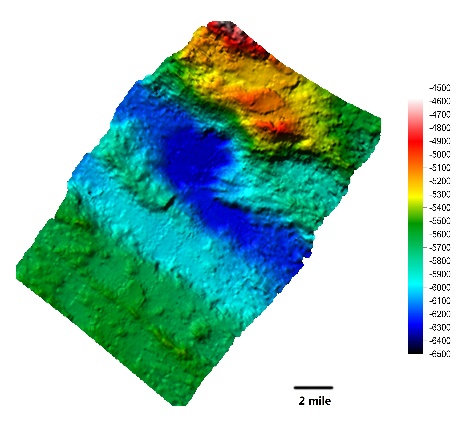As one of the most advanced marine high-tech equipment in the world today, multibeam sounding system (MBSS) is an important means to obtain seawater depth data and seabed topography.
The full-ocean MBSS is used for the detection of high-precision seabed topography within 20 to 11000 meters of depth.
Recently, the full-ocean MBSS engineering prototype was accomplished by the research team led by researcher LIU Xiaodong from Ocean Acoustic Technology Center of the Institute of Acoustics (IOA) of the Chinese Academy of Sciences, which is ready for acting as a high-precision “searchlight” to scan deep sea clearly.

Figure 1. Seabed at 6000 meters depth is uneven, told by the full-ocean MBSS.(Image by IOA)
Several years ago, only a few countries, like Norway and Germany, can produce the equipment.
In 2014, after six years of research and development, the IOA team, together with colleagues of the 863 Plan “deep water MBSS development” project, achieved a zero breakthrough in the full-ocean MBSS technology.
Today, another four years past, researchers developed an engineering prototype, which breaks new ground in key technologies under heavy noise condition, such as multibeam signal processing, real-time beam stabilization, underwater acoustic arrays with good consistency, and electronic system production, while improves sounding accuracy of the system at the same time.
Researchers has completed more than 6,000 kilometers of sea trials in the South China Sea, the Northwest Pacific and the Indian Ocean, proving that the full-ocean MBSS engineering prototype is reliable for practical application of seabed mapping and scientific research.
As outcome of a project in the National Key Technologies R&D Program of China during China’s 12th Five-Year Plan, the full-ocean MBSS engineering prototype was developed jointly by researchers from the 715th Research Institute of China Shipbuilding Industry Corporation, the Second Institute of Oceanography of the State Oceanic Administration, the South China Sea Institute of Oceanology of the Chinese Academy of Sciences, Nanfoon Applied Technology Ltd. and Zhejiang University.
Contact:
WANG Rongquan
Institute of Acoustics, Chinese Academy of Sciences, 100190 Beijing, China
E-mail: media@mail.ioa.ac.cn


